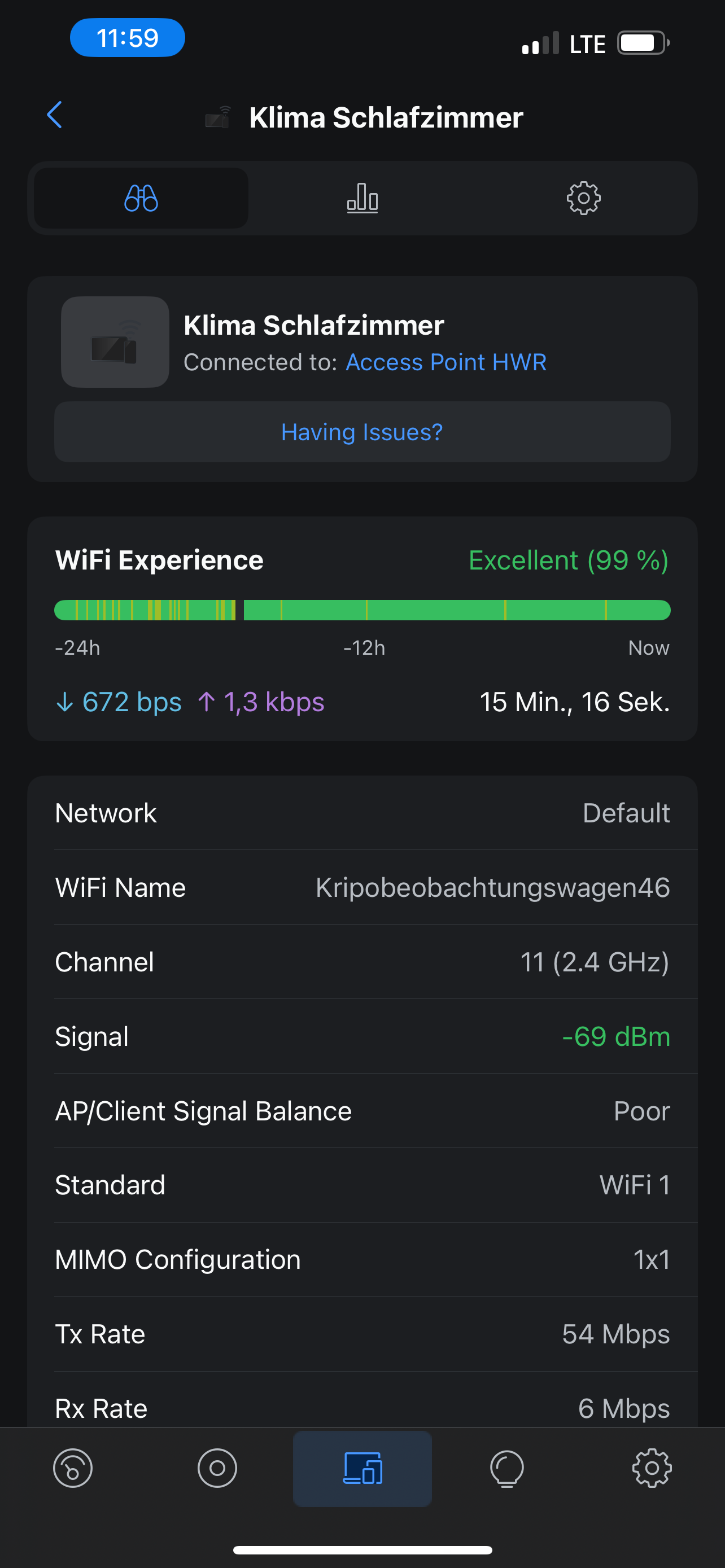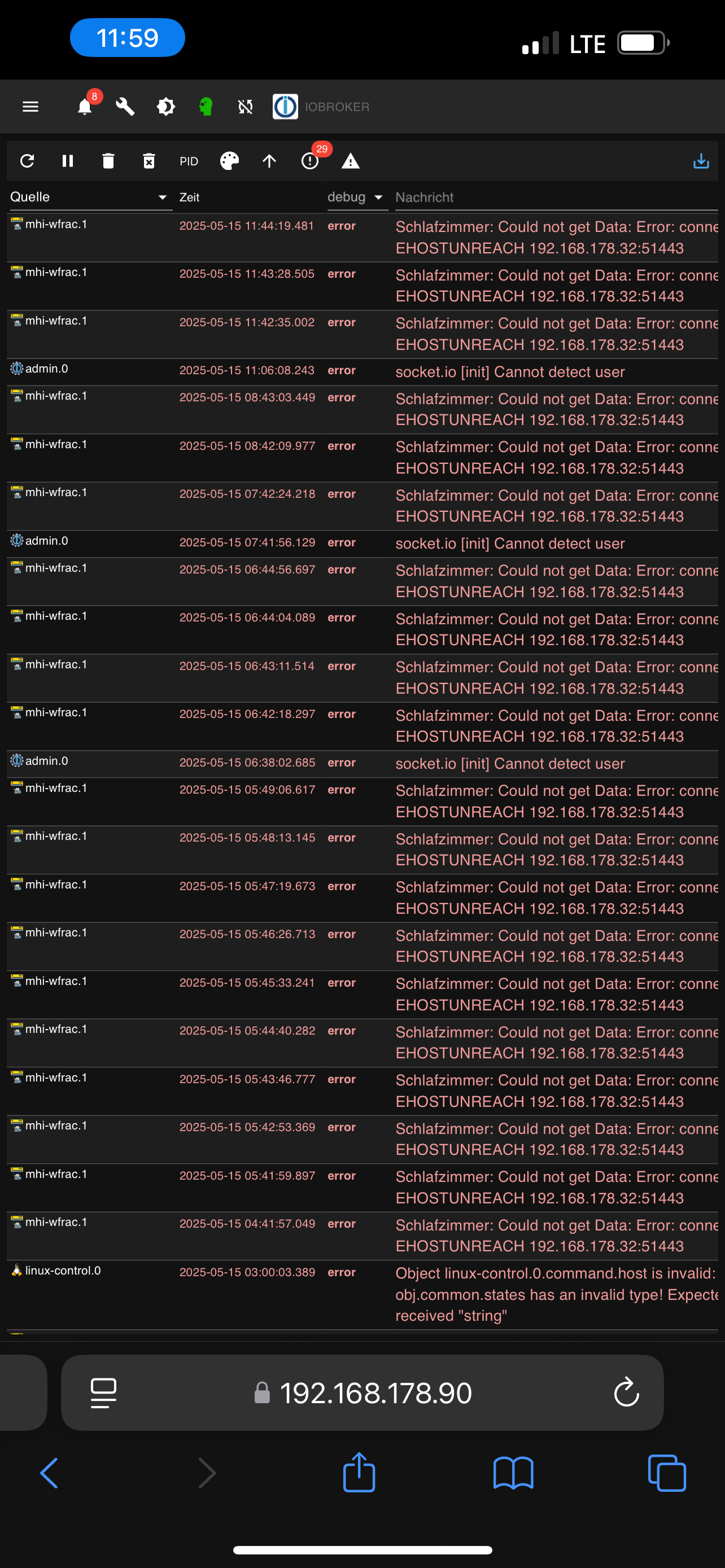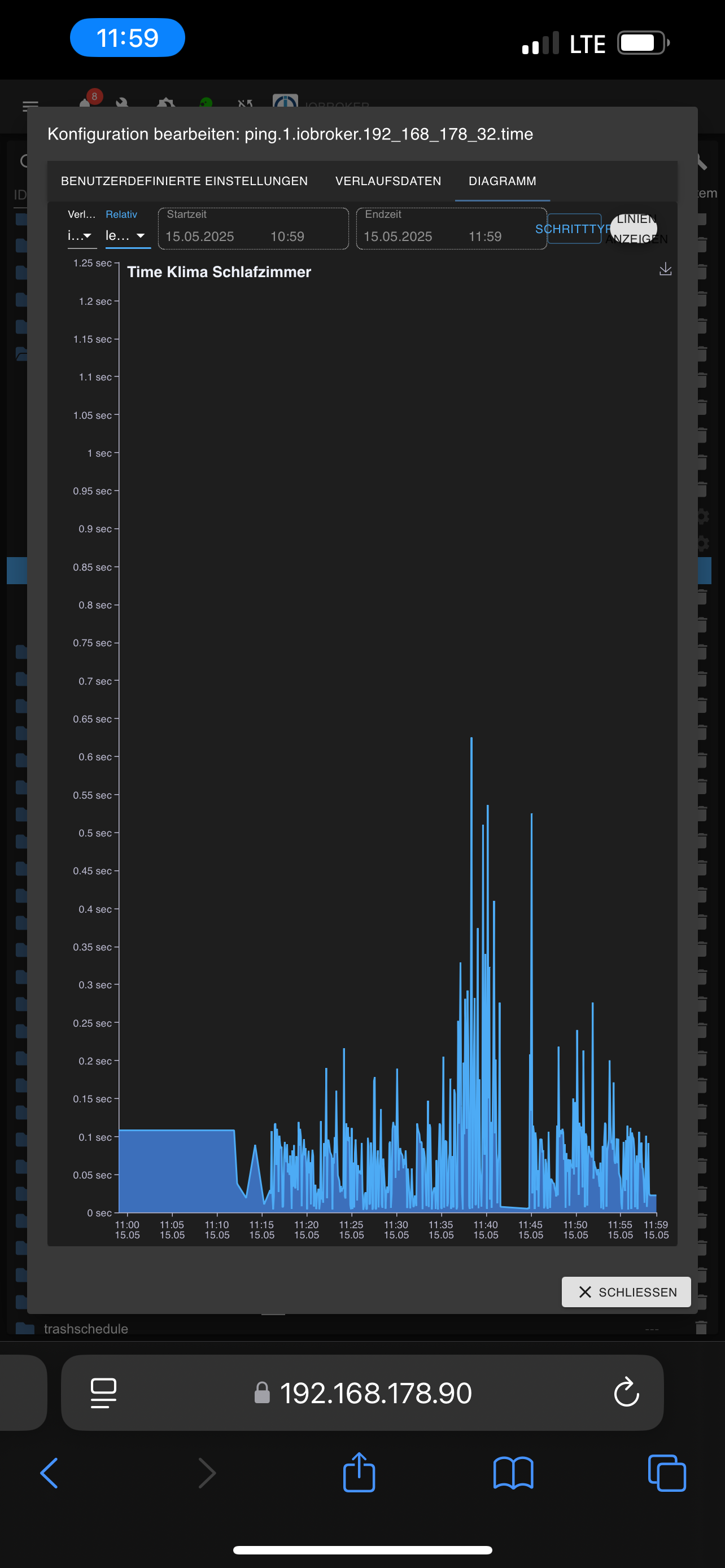NEWS
Mitsubishi Heavy Industries Split Klimaanlage
-
@hacki11 sagte in Mitsubishi Heavy Industries Split Klimaanlage:
@saeft_2003 Es wird im angegebenen Interval abgefragt. Bei einer erfolgreichen Abfrage wird der Datenpunkt "online" auf true gesetzt. Bei jedem Intervall werden am Ende alle online Datenpunkte evaluiert und sofern alle true sind, wird der Gesamstatus auch aktualisiert. So sollte sich der Zustand auch ohne Neustart wieder fangen. Du könntest das nächste mal schauen, ob alle online Datenpunkte der aktiven Geräte true sind und der Adapterzustand dennoch gelb.
Alles klar falls das wieder vorkommt mache ich das.
-
Denke ich habs. Intervall ping alle 60 sek?

-
@saeft_2003 Jede Sekunde
-
Das lässt der ping adapter nicht zu. kürzester intervall sind alle 5 sek.
-
@saeft_2003 passt auch noch
-
Alles klar ich lass das mal bis morgen so laufen und schau ob ich in grafana was sehe und melde mich.
-
-
Das sieht mir nach einer schlechten WLAN-Verbindung aus.
-
@saeft_2003 Nimm mal den alive mit in die history auf. Aber man sieht schon schön ne Lücke in dem Graphen. Vermutlich gab’s keine Werte und es wird linear mit dem ersten Ping der wiederkommt verbunden? Zumindest würde das den Graphen erklären.
-
Ich hab die Klima jetzt wieder auf den AP gelockt der theoretisch am besten ist. Normalerweise muss die Verbindung hier top sein. Luftlinie ist der nur 2m weg und nur dünne Wände dazwischen. Andere Geräte zum Teil weiter weg haben null Probleme.
-
@saeft_2003 Mein IG nimmt auch immer den weiter entfernten AP statt dem der 4m entfernt steht. Roaming ist in dem WLAN deaktiviert, da viele IOT Geräte damit nicht klar kommen. Das IG vermutlich gleich dreimal nicht.
-
@hacki11 Ich habe das WLAN so konfiguriert, dass die Geräte in einem separaten WLAN in 2.4Ghz am jeweils nächstliegenden AP eingesperrt sind. Habe kurz ein Shellscript für Linux mit Chat GPT entwickelt, was ne csv mitloggt (im Subfolder "Log" im Scriptordner. Inhalt der CSV:
Name;Zeitstempel;Erreichbar;Zeit(ms) Klima-Spitzboden;2025-05-15 13:39:18;True;30.4 Klima-K1;2025-05-15 13:39:18;True;85.3 Klima-K2;2025-05-15 13:39:18;True;95.8Ist auch ein Billigfrontend drauf:

Hier das Script (IPs und Aliase anpassen!):
#!/bin/bash # Intervall in Sekunden INTERVAL=5 # IP-Adressen und Aliasnamen IPS=("192.168.120.135" "192.168.120.138" "192.168.120.137" "192.168.120.136" "192.168.120.166") ALIASES=("Klima-Spitzboden" "Klima-K1" "Klima-K2" "Klima-Esszimmer" "Klima-Buero") # Logging-Verzeichnis und -Datei SCRIPT_DIR="$(cd "$(dirname "${BASH_SOURCE[0]}")" && pwd)" LOG_DIR="$SCRIPT_DIR/log" CSV_FILE="$LOG_DIR/ping_log.csv" mkdir -p "$LOG_DIR" # CSV-Datei initialisieren, falls noch nicht vorhanden if [ ! -f "$CSV_FILE" ]; then echo "Name;Zeitstempel;Erreichbar;Zeit(ms)" >> "$CSV_FILE" fi # Statusspeicher declare -A LAST_RESPONSE declare -A LAST_SEEN_DOWN # Spaltenbreiten WIDTH_ALIAS=20 WIDTH_REACH=12 WIDTH_TIME=10 WIDTH_LASTDOWN=25 # Initialisieren for alias in "${ALIASES[@]}"; do LAST_RESPONSE["$alias"]="-" LAST_SEEN_DOWN["$alias"]="-" done # Letzte bekannte False-Zeiten aus CSV rekonstruieren if [ -f "$CSV_FILE" ]; then for alias in "${ALIASES[@]}"; do last_false=$(grep "^$alias;" "$CSV_FILE" | grep ";False;" | tail -n 1 | cut -d';' -f2) if [ -n "$last_false" ]; then epoch=$(date -d "$last_false" +%s 2>/dev/null) if [ -n "$epoch" ]; then LAST_SEEN_DOWN["$alias"]=$epoch fi fi done fi # Funktion für menschenlesbare Zeitangabe time_diff_human() { local last_time=$1 [[ "$last_time" == "-" ]] && echo "-" && return local now=$(date +%s) local diff=$((now - last_time)) (( diff < 60 )) && echo "vor $diff Sek." && return (( diff < 3600 )) && echo "vor $((diff / 60)) Min." && return echo "vor $((diff / 3600)) Std." } # Hauptschleife while true; do clear printf "%-${WIDTH_ALIAS}s | %-${WIDTH_REACH}s | %-${WIDTH_TIME}s | %-${WIDTH_LASTDOWN}s\n" "Alias" "Erreichbar" "Zeit(ms)" "Nicht erreichbar vor" printf "%-${WIDTH_ALIAS}s-+-%-${WIDTH_REACH}s-+-%-${WIDTH_TIME}s-+-%-${WIDTH_LASTDOWN}s\n" \ "$(printf '─%.0s' $(seq 1 $WIDTH_ALIAS))" \ "$(printf '─%.0s' $(seq 1 $WIDTH_REACH))" \ "$(printf '─%.0s' $(seq 1 $WIDTH_TIME))" \ "$(printf '─%.0s' $(seq 1 $WIDTH_LASTDOWN))" for i in "${!IPS[@]}"; do IP=${IPS[$i]} NAME=${ALIASES[$i]} TIMESTAMP_HUMAN=$(date '+%Y-%m-%d %H:%M:%S') TIMESTAMP_EPOCH=$(date +%s) PING_OUTPUT=$(ping -c 1 -W 1 "$IP" 2>/dev/null) if echo "$PING_OUTPUT" | grep -q "1 received"; then TIME_MS=$(echo "$PING_OUTPUT" | grep "time=" | sed -E 's/.*time=([0-9.]+) ms/\1/') LAST_RESPONSE["$NAME"]=$TIME_MS REACH="Ja" DOWNTIME=$(time_diff_human "${LAST_SEEN_DOWN[$NAME]}") echo "$NAME;$TIMESTAMP_HUMAN;True;$TIME_MS" >> "$CSV_FILE" else REACH="Nein" TIME_MS="-" if [[ "${LAST_SEEN_DOWN[$NAME]}" == "-" ]]; then LAST_SEEN_DOWN["$NAME"]=$TIMESTAMP_EPOCH fi DOWNTIME=$(time_diff_human "${LAST_SEEN_DOWN[$NAME]}") echo "$NAME;$TIMESTAMP_HUMAN;False;" >> "$CSV_FILE" fi printf "%-${WIDTH_ALIAS}s | %-${WIDTH_REACH}s | %-${WIDTH_TIME}s | %-${WIDTH_LASTDOWN}s\n" \ "$NAME" "$REACH" "${LAST_RESPONSE[$NAME]}" "$DOWNTIME" done sleep "$INTERVAL" doneFalls Ihr irgendwo Linux habt, könnt Ihr das da laufen lassen.
Und hier das Script, um die CSV als Bild darzustellen:
#!/usr/bin/env python3 import pandas as pd import matplotlib.pyplot as plt from datetime import timedelta import matplotlib.dates as mdates import os # 🕒 Benutzerabfrage zum Stundenbereich try: user_input = input("Wie viele Stunden zurück anzeigen? [Default: 24]: ").strip() MAX_HOURS = int(user_input) if user_input else 24 except Exception: MAX_HOURS = 24 # 📥 CSV einlesen CSV_PATH = "./log/ping_log.csv" df = pd.read_csv(CSV_PATH, sep=';') df['Zeitstempel'] = pd.to_datetime(df['Zeitstempel'], format="%Y-%m-%d %H:%M:%S") df['Farbe'] = df['Erreichbar'].apply(lambda x: 'green' if str(x).strip().lower() == 'true' else 'red') df['Erreichbar_bool'] = df['Erreichbar'].apply(lambda x: str(x).strip().lower() == 'true') # 🧭 Zeitbereich setzen latest_time = df['Zeitstempel'].max() earliest_time = df['Zeitstempel'].min() start_time = max(earliest_time, latest_time - timedelta(hours=MAX_HOURS)) df = df[df['Zeitstempel'] >= start_time].copy() # 📋 Aliasnamen extrahieren aliases = df['Name'].unique() aliases_sorted = list(aliases) # 📁 Diagrammverzeichnis erstellen output_dir = "./diagramm_pix" os.makedirs(output_dir, exist_ok=True) # 📊 Plot vorbereiten fig, ax = plt.subplots(figsize=(14, len(aliases_sorted) * 1.2)) def plot_status_blocks(data, y_pos): current_color = None block_start = None for _, row in data.iterrows(): color = row['Farbe'] timestamp = row['Zeitstempel'] if color != current_color: if current_color is not None: duration = (timestamp - block_start).total_seconds() ax.barh( y=y_pos, width=duration / 3600, left=block_start, height=0.6, color=current_color, edgecolor='none' ) block_start = timestamp current_color = color if block_start is not None and current_color is not None: duration = (latest_time - block_start).total_seconds() ax.barh( y=y_pos, width=duration / 3600, left=block_start, height=0.6, color=current_color, edgecolor='none' ) for i, alias in enumerate(aliases_sorted): data = df[df['Name'] == alias].sort_values(by='Zeitstempel') plot_status_blocks(data, i) # 📐 Achsen und Format ax.set_yticks(range(len(aliases_sorted))) ax.set_yticklabels(aliases_sorted) ax.set_xlim(start_time, latest_time) ax.invert_yaxis() ax.xaxis.set_major_formatter(mdates.DateFormatter('%H:%M')) ax.set_xlabel("Uhrzeit") ax.set_title("Erreichbarkeit der IPs – zusammenhängende Zustandsbereiche") plt.grid(axis='x', linestyle='--', alpha=0.5) plt.tight_layout() # 💾 Bild speichern image_filename = f"{output_dir}/ping_status_{latest_time.strftime('%Y%m%d_%H%M%S')}.png" plt.savefig(image_filename) plt.show() # 📋 Zusammenfassung pro Alias print("\nZusammenfassung:") total_minutes = MAX_HOURS * 60 for alias in aliases_sorted: alias_data = df[df['Name'] == alias].sort_values(by='Zeitstempel') alias_data['diff'] = alias_data['Zeitstempel'].diff().dt.total_seconds().fillna(0) # Statuswechsel ermitteln alias_data['is_new_block'] = (alias_data['Erreichbar_bool'] != alias_data['Erreichbar_bool'].shift()) alias_data['block_id'] = alias_data['is_new_block'].cumsum() # Offline-Blöcke false_blocks = alias_data[alias_data['Erreichbar_bool'] == False] grouped = false_blocks.groupby('block_id') total_offline_secs = grouped['diff'].sum().sum() total_offline_minutes = round(total_offline_secs / 60, 2) total_outages = grouped.ngroups outages_per_hour = round(total_outages / MAX_HOURS, 2) avg_offline_per_hour = round(total_offline_minutes / MAX_HOURS, 2) # Antwortzeiten nur bei True true_responses = alias_data[alias_data['Erreichbar_bool'] == True].copy() true_responses['Zeit(ms)'] = pd.to_numeric(true_responses['Zeit(ms)'], errors='coerce') min_time = round(true_responses['Zeit(ms)'].min(), 2) avg_time = round(true_responses['Zeit(ms)'].mean(), 2) max_time = round(true_responses['Zeit(ms)'].max(), 2) print(f"{alias}:") print(f" Gesamtofflinezeit: {total_offline_minutes:.2f} Min") print(f" Ø Offlinezeit/Stunde: {avg_offline_per_hour:.2f} Min") print(f" Gesamtzahl Ausfälle: {total_outages}") print(f" Ø Ausfälle/Stunde: {outages_per_hour}") print(f" Antwortzeit (Min/Ø/Max): {min_time:.2f} / {avg_time:.2f} / {max_time:.2f} ms\n") -
@mrlarodos Habe mir noch ein Script gebaut, das die CSV als Diagramm visualisiert:
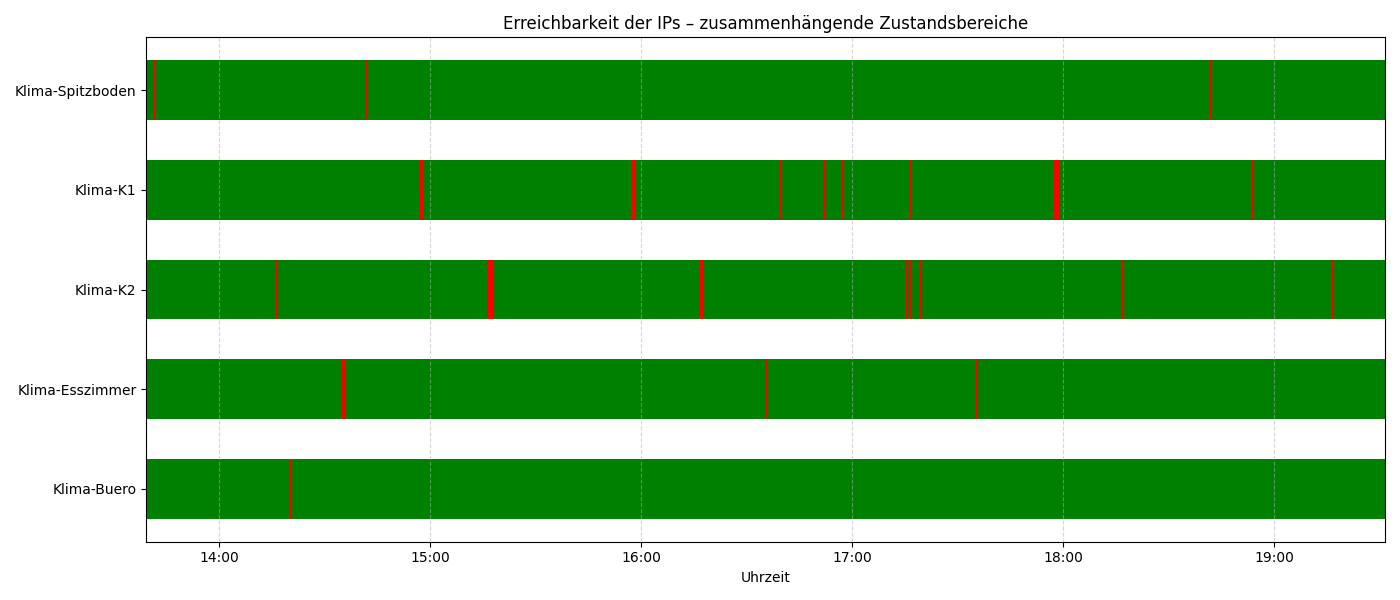
Und hier die Zusammenfassung der bisherigen Messung:
Klima-Spitzboden:
Gesamtofflinezeit: 3.50 Min
Ø Offlinezeit/Stunde: 0.15 Min
Gesamtzahl Ausfälle: 19
Ø Ausfälle/Stunde: 0.79
Antwortzeit (Min/Ø/Max): 4.30 / 82.30 / 878.00 msKlima-K1:
Gesamtofflinezeit: 6.25 Min
Ø Offlinezeit/Stunde: 0.26 Min
Gesamtzahl Ausfälle: 21
Ø Ausfälle/Stunde: 0.88
Antwortzeit (Min/Ø/Max): 4.09 / 77.67 / 452.00 msKlima-K2:
Gesamtofflinezeit: 6.42 Min
Ø Offlinezeit/Stunde: 0.27 Min
Gesamtzahl Ausfälle: 28
Ø Ausfälle/Stunde: 1.17
Antwortzeit (Min/Ø/Max): 3.88 / 85.14 / 680.00 msKlima-Esszimmer:
Gesamtofflinezeit: 3.35 Min
Ø Offlinezeit/Stunde: 0.14 Min
Gesamtzahl Ausfälle: 8
Ø Ausfälle/Stunde: 0.33
Antwortzeit (Min/Ø/Max): 3.74 / 78.01 / 979.00 msKlima-Buero:
Gesamtofflinezeit: 0.18 Min
Ø Offlinezeit/Stunde: 0.01 Min
Gesamtzahl Ausfälle: 2
Ø Ausfälle/Stunde: 0.08
Antwortzeit (Min/Ø/Max): 4.20 / 73.71 / 993.00 msHm. Hilft uns das sehr?

-
@mrlarodos Zur Sicherheit mal den Adapter stoppen und prüfen ob die Offlinezeit dadurch beeinflusst wird. Falls nicht ist zumindest der Adapter raus 🫠
-
@hacki11 Gute Idee
 Ich hoffe, dann ist alles grün
Ich hoffe, dann ist alles grün  <sleep canceled> ist dann angesagt
<sleep canceled> ist dann angesagt 
-
@mrlarodos So, der Adapter ist aus. Nun wird es spannend


-
-
Ich lass mal noch ein paar Stunden laufen und dann checken wir. Ich vermute eher, dass die Verbindung von den Dingern einfach nicht besonders stabil ist. Büro besonders stabil, weil der AP 2 Meter in Sichtlinie liegt. Schauen wir mal.
-
@mrlarodos So, um 20:20 Uhr hatte ich den Adapter deaktiviert:
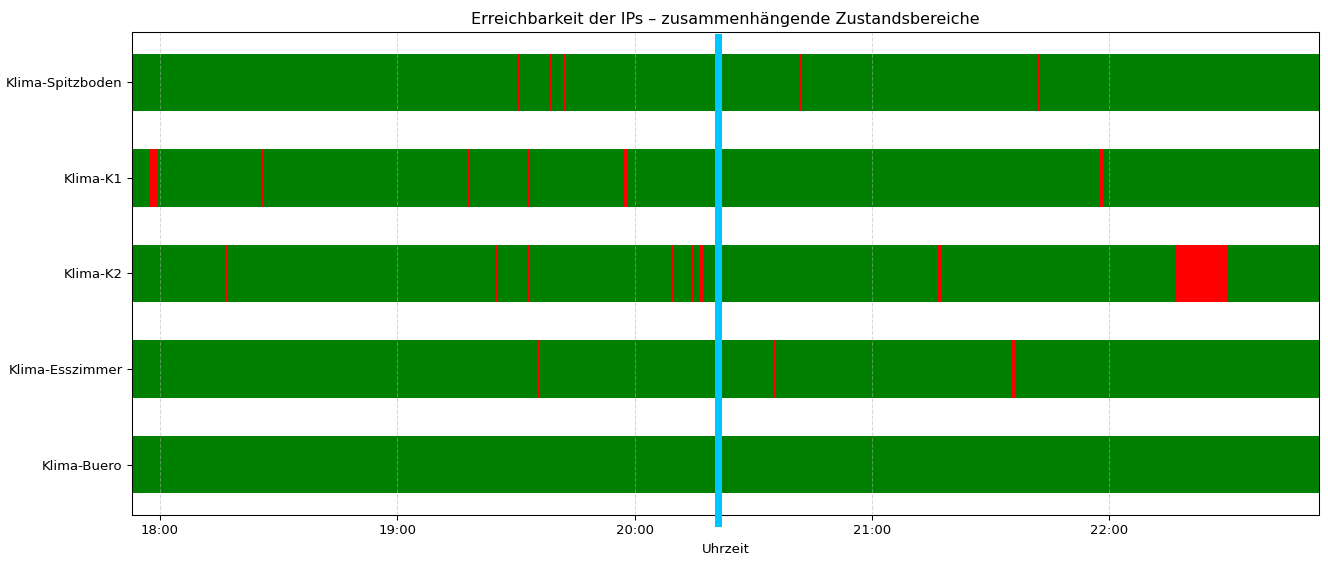
Ab der blauen Linie also. Danach sind zwar weniger kleine Abbrüche erkennbar, aber das Phänomen ist nicht weg.Signalstärke ist bei Klima-K1, Klima-K2 und Spitzboden bei ca. -47 dBm / -50 dBm, also kein großer Unterschied und auch kein erklärend schlechter Wert, oder?
Im Büro sind es -31 dBm und Esszimmer -35 dBm, da beide Sichtline zum AP haben. K1, K2 und Spitzboden sind auch nur 1 - 3 Meter vom AP entfernt, wenn auch ohne Sichtlinie.
Feste Kopplung an den jeweils nächsten AP und separates, eigenes WLAN mit 2,4 Ghz. Bin da etwas ratlos und kann nur mutmaßen, dass die WLAN-Module einfach nicht sehr gut sind.
Dass der Adapter runtergefahren ist, die Objekte aber weiterhin als online angezeigt werden, kannst Du nicht ändern, oder? Falls es möglich ist bei proaktivem Abschalten des Adapters auch noch ein Stopscript laufen zu lassen, wäre ein offline in den Objekten und der "Summe" wünschenswert

Ansonsten kann man wohl nicht viel machen. Der fette Ausfall der Pingbarkeit von K2 ist schon Mist ...
LG MrLarodos
-
@mrlarodos Ohne, dass der Adapter läuft kann man die Erreichbarkeit der IG nicht wissen. Offline ist hier dann genauso falsch wie online. Wie ist es denn bei den anderen Adaptern wie Shelly? Wird hier auch noch was vorm beenden verändert? Der letzte bekannte Zustand ist der beste den wir haben. Falls es um ne Vis geht bräuchte man evtl. den Adapterzustand oder?
Ansonsten gut analysiert. Wer mag ein WLan Modul zerlegen, damit wir sehen was da drin ist? Vielleicht findet man auch noch Infos in englischsprachigen Foren.
